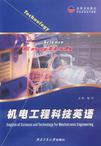机电工程科技英语
出版时间:2007-8 出版社:西北工大 作者:陶华 编 页数:301 字数:470000
内容概要
本书以机电工程领域的英语文献为教学内容,全书包括:工程材料、金属成形、机械零件、计算机应用、工业设计、数控加工、计算机集成制造、特种加工、机电学与测量系统、汽车、飞机设计、飞机制造、微机电系统、机器人、工业工程等17个单元的教学内容,另外还包括了科技英语翻译、科技英语写作等科技英语技能拓展辅助教学内容。 本书旨在提高学生的专业英语快速阅读理解能力,同时希望能锻炼英文写作能力。 本书适合于理工科大专院校机械工程或机电工程专业的学生学习使用,也可供专业技术人员阅读。
书籍目录
Unit 1 Engineering Materials Text 1 Type of Materials Text 2 Steel Text 3 Polymer Text 4 Mechanical Properties of Material Free Reading ExerciseUnit 2 Material Forming Text 1 Metal Forming Text 2 sheet Forming Text 3 Forging Text 4 Injection Molding Free Reading ExerciseUnit 3 Mechanical Components Text 1 Basic Machines and Machine Components Text 2 Rolling Element Bearings Text 3 Flexible Mechanical Elements Text 4 Gear Free Reading ExerciseUnit 4 Computer Applications Ⅰ Text 1 Computers: Getting Started Text 2 Computer Aided Design Text 3 Computer Aided Engineering Text 4 Introduction to New DMU Technology Free Reading ExerciseUnit 5 Computer Applications Ⅱ Text 1 Computer Aided Process Planning Text 2 Computer Aided Manufacturing Text 3 Computer Aided Quality Control Text 4 Agile Manufacturing and Green Product Manufacturing Free Reading ExerciseUnit 6 Introduction to Industrial Design Text 1 What Is Industrial Design? Text 2 Fundamental Entry-Level Requirements for Industrial Designers Text 3 Design and Culture Text 4 Ergonomics Text 5 Green Design Free Reading ExerciseUnit 7 Practice of Industrial Design Text 1 Organic Geometry Ⅰ Text 2 Organic Geometry Ⅱ Text 3 CAD vs. CAID Text 4 Studio Tools 10--Computer Aided Industrial Design Free Reading ExerciseUnit 8 CNC Machines Text I The Fundamentals of CNC Text 2 How CNC Works Text 3 Structures of CNC Machines Text 4 Types of CNC Machines Free Reading ExerciseUnit 9 Computer-Integrated Manufacturing Text 1 Activities for Manufacturing Systems Text 2 Flexible Manufacturing Systems Text 3 Computer-Integrated Manufacturing Technology ExerciseUnit 10 Non-Conventional Machine Text 1 Electrical Machining Processes Text 2 Development Trends of Erosion Machining Text 3 Application Areas of RP&M Free Reading ExerciseUnit 11 Meehatronies and Measurement Systems Text 1 Mechatronics Text 2 Measurement Systems Text 3 Measurement System Response Text 4 Sensors for Mechanical Measurements Text 5 Temperature Measurement Free Reading ExerciseUnit 12 Automobile Text 1 Fundamentals of Automobile Text 2 How an Energy Works Text 3 Transmission Text 4 Suspension and Steering Systems Operation Free Reading ExerciseUnit 13 Aircraft Design Text 1 Phases of Aircraft Design Text 2 Aircraft Conceptual Design Text 3 Loads on Aircraft Structural Components Text 4 Function of Structural Components Free Reading ExerciseUnit 14 Aircraft Fabrication Text 1 Fabrication of Structural Components Text 2 A Flexible Development System for Automated Aircraft Assembly Text 3 A New Look at Aircraft Assembly--Friction Stir Welding Is the Answer Text 4 Verifying Aircraft Assembly with Real-Time Digital hotogrammetry ExerciseUnit 15 MEMS Text 1 Introduction to MEMS Text 2 Mechanical to Electrical Transduction Text 3 MEMS Actuators Text 4 Trends in MEMS Technology ExerciseUnit 16 Robotics Text 1 Robotics Text 2 Industrial Robots Text 3 Component of a Robot System Text 4 Robotic Sensors Free Reading ExerciseUnit 17 Industry Engineering Text 1 Industrial Engineering Education for the 21st Century Text 2 Real IE Value Text 3 Operations Research Text 4 Total Quality Management ExerciseDevelopment Skills for Technical EnglishAppendix 1 A List of Common British and American Spelling Equivalents 2 A List of Common Prefixes and SuffixesBibliography
章节摘录
Mechanical properties mean a material's ability to carry or resist the application of mechanical forces and loads.The material's reaction to these forces is usually either deformation or fracture.Mechanical properties are probably the most important to manufacturing processing.They determine the extent to which a material may be formed, sheared, or machined.Typical forces which are applied to a material are tension, compression, shear, and torsion, these forces are used to form and shape materials. Furthermore, materials must withstand excess amounts of these forces in product applications. Since screws are used to assemble wood parts," they must absorb torsion forces. Rods holding suspended fixtures must withstand excess tension forces.The head of a hammer must absorb compression forces.(1) Stress-strain. The stress-strain relationship is often used to study many mechanical properties. Stress is force applied to material. It is usually measured in either pounds per square inch or kilograms per square centimeter. Strain is the change in the length of a material which is under stress. The strain measurements are given in term of the amount of elongation of the material per unit of length. Strain is given in thousandths of an inch per inch of material of millimeters (of smaller units) per centimeter of material. For most materials, the elongation of a material under stress is quite small. ……
图书封面
评论、评分、阅读与下载
用户评论 (总计0条)
相关图书
- 大学英语快速阅读教程(第2册)
- 大学英语快速阅读教程(第3册)
- 极品人
- 大学体育教程
- 生物化学实验指导
- 海德格尔与《存在与时间》
- 72变日语语法与会话
- 新商务日语基础教程
- 走进阳春-山水画廊之旅
- The "Beatles": Ten Years That Shook the World (平装)
- 2007 小草地貳年級 Grassfest / 2
- 国债风险控制体系研究-中青年经济学家文库
- 税收学
- 民事诉讼法
- 房地产估价实务与案例
- 动物解剖
- 苹果梨优质丰产栽培技术 (平装)
- 金文的世界——殷周社会史
- 室内方案集成1
- 中国青铜器的奥秘
- 慢慢來,比較快
- 可编程控制器原理及应用
- 大学生职业规划与就业指导
- 中国历代文论选新编.先秦至唐五代卷
- 加菲猫
